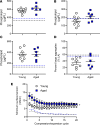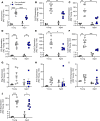Effect of aging on pulmonary cellular responses during mechanical ventilation
- PMID: 39946196
- PMCID: PMC11949020
- DOI: 10.1172/jci.insight.185834
Effect of aging on pulmonary cellular responses during mechanical ventilation
Abstract
Acute respiratory distress syndrome (ARDS) results in substantial morbidity and mortality, especially in elderly people. Mechanical ventilation, a common supportive treatment for ARDS, is necessary for maintaining gas exchange but can also propagate injury. We hypothesized that aging leads to alterations in surfactant function, inflammatory signaling, and microvascular permeability within the lung during mechanical ventilation. Young and aged male mice were mechanically ventilated, and surfactant function, inflammation, and vascular permeability were assessed. Additionally, single-cell RNA-Seq was used to delineate cell-specific transcriptional changes. The results showed that, in aged mice, surfactant dysfunction and vascular permeability were significantly augmented, while inflammation was less pronounced. Differential gene expression and pathway analyses revealed that alveolar macrophages in aged mice showed a blunted inflammatory response, while aged endothelial cells exhibited altered cell-cell junction formation. In vitro functional analysis revealed that aged endothelial cells had an impaired ability to form a barrier. These results highlight the complex interplay between aging and mechanical ventilation, including an age-related predisposition to endothelial barrier dysfunction, due to altered cell-cell junction formation, and decreased inflammation, potentially due to immune exhaustion. It is concluded that age-related vascular changes may underlie the increased susceptibility to injury during mechanical ventilation in elderly patients.
Keywords: Aging; Endothelial cells; Macrophages; Pulmonary surfactants; Pulmonology; Vascular biology.
Figures














Similar articles
-
The HDL from septic-ARDS patients with composition changes exacerbates pulmonary endothelial dysfunction and acute lung injury induced by cecal ligation and puncture (CLP) in mice.Respir Res. 2020 Nov 4;21(1):293. doi: 10.1186/s12931-020-01553-3. Respir Res. 2020. PMID: 33148285 Free PMC article.
-
Functional roles of CD26/DPP4 in lipopolysaccharide-induced lung injury.Am J Physiol Lung Cell Mol Physiol. 2024 May 1;326(5):L562-L573. doi: 10.1152/ajplung.00392.2022. Epub 2024 Mar 12. Am J Physiol Lung Cell Mol Physiol. 2024. PMID: 38469626 Free PMC article.
-
mTORC1 is a mechanosensor that regulates surfactant function and lung compliance during ventilator-induced lung injury.JCI Insight. 2021 Jul 22;6(14):e137708. doi: 10.1172/jci.insight.137708. JCI Insight. 2021. PMID: 34138757 Free PMC article.
-
Mechanisms of acute respiratory distress syndrome: role of surfactant changes and mechanical ventilation.J Physiol Pharmacol. 1997 Dec;48(4):537-57. J Physiol Pharmacol. 1997. PMID: 9444607 Review.
-
Pathophysiology of Acute Respiratory Distress Syndrome and COVID-19 Lung Injury.Crit Care Clin. 2021 Oct;37(4):749-776. doi: 10.1016/j.ccc.2021.05.003. Epub 2021 May 28. Crit Care Clin. 2021. PMID: 34548132 Free PMC article. Review.
References
MeSH terms
Substances
LinkOut - more resources
Full Text Sources
Medical

